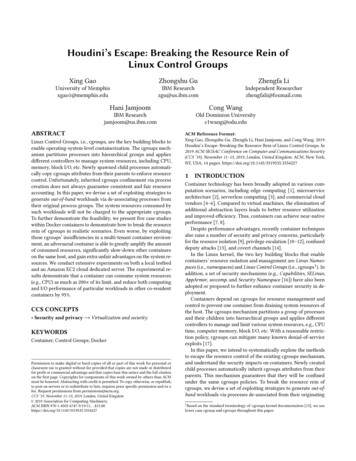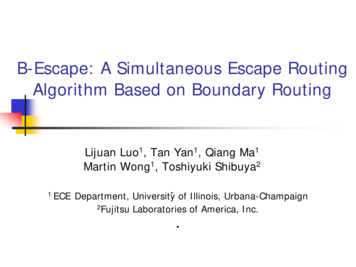
Transcription
Houdini’s Escape: Breaking the Resource Rein ofLinux Control GroupsXing GaoUniversity of Memphisxgao1@memphis.eduZhongshu GuZhengfa LiIBM Researchzgu@us.ibm.comHani JamjoomCong WangIBM Researchjamjoom@us.ibm.comABSTRACTLinux Control Groups, i.e., cgroups, are the key building blocks toenable operating-system-level containerization. The cgroups mechanism partitions processes into hierarchical groups and appliesdifferent controllers to manage system resources, including CPU,memory, block I/O, etc. Newly spawned child processes automatically copy cgroups attributes from their parents to enforce resourcecontrol. Unfortunately, inherited cgroups confinement via processcreation does not always guarantee consistent and fair resourceaccounting. In this paper, we devise a set of exploiting strategies togenerate out-of-band workloads via de-associating processes fromtheir original process groups. The system resources consumed bysuch workloads will not be charged to the appropriate cgroups.To further demonstrate the feasibility, we present five case studieswithin Docker containers to demonstrate how to break the resourcerein of cgroups in realistic scenarios. Even worse, by exploitingthose cgroups’ insufficiencies in a multi-tenant container environment, an adversarial container is able to greatly amplify the amountof consumed resources, significantly slow-down other containerson the same host, and gain extra unfair advantages on the system resources. We conduct extensive experiments on both a local testbedand an Amazon EC2 cloud dedicated server. The experimental results demonstrate that a container can consume system resources(e.g., CPU) as much as 200 of its limit, and reduce both computingand I/O performance of particular workloads in other co-residentcontainers by 95%.CCS CONCEPTS Security and privacy Virtualization and security.KEYWORDSContainer; Control Groups; DockerPermission to make digital or hard copies of all or part of this work for personal orclassroom use is granted without fee provided that copies are not made or distributedfor profit or commercial advantage and that copies bear this notice and the full citationon the first page. Copyrights for components of this work owned by others than ACMmust be honored. Abstracting with credit is permitted. To copy otherwise, or republish,to post on servers or to redistribute to lists, requires prior specific permission and/or afee. Request permissions from permissions@acm.org.CCS ’19, November 11–15, 2019, London, United Kingdom 2019 Association for Computing Machinery.ACM ISBN 978-1-4503-6747-9/19/11. . . ndent Researcherzhengfali@foxmail.comOld Dominion Universityc1wang@odu.eduACM Reference Format:Xing Gao, Zhongshu Gu, Zhengfa Li, Hani Jamjoom, and Cong Wang. 2019.Houdini’s Escape: Breaking the Resource Rein of Linux Control Groups. In2019 ACM SIGSAC Conference on Computer and Communications Security(CCS ’19), November 11–15, 2019, London, United Kingdom. ACM, New York,NY, USA, 14 pages. ONContainer technology has been broadly adopted in various computation scenarios, including edge computing [1], microservicearchitecture [2], serverless computing [3], and commercial cloudvendors [4–6]. Compared to virtual machines, the elimination ofadditional abstraction layers leads to better resource utilizationand improved efficiency. Thus, containers can achieve near-nativeperformance [7, 8].Despite performance advantages, recently container techniquesalso raise a number of security and privacy concerns, particularlyfor the resource isolation [9], privilege escalation [10–12], confuseddeputy attacks [13], and covert channels [14].In the Linux kernel, the two key building blocks that enablecontainers’ resource isolation and management are Linux Namespaces (i.e., namespaces) and Linux Control Groups (i.e., cgroups1 ). Inaddition, a set of security mechanisms (e.g., Capabilities, SELinux,AppArmor, seccomp, and Security Namespace [16]) have also beenadopted or proposed to further enhance container security in deployment.Containers depend on cgroups for resource management andcontrol to prevent one container from draining system resources ofthe host. The cgroups mechanism partitions a group of processesand their children into hierarchical groups and applies differentcontrollers to manage and limit various system resources, e.g., CPUtime, computer memory, block I/O, etc. With a reasonable restriction policy, cgroups can mitigate many known denial-of-serviceexploits [17].In this paper, we intend to systematically explore the methodsto escape the resource control of the existing cgroups mechanism,and understand the security impacts on containers. Newly createdchild processes automatically inherit cgroups attributes from theirparents. This mechanism guarantees that they will be confinedunder the same cgroups policies. To break the resource rein ofcgroups, we devise a set of exploiting strategies to generate out-ofband workloads via processes de-associated from their originating1 Basedon the standard terminology of cgroups kernel documentation [15], we uselower case cgroup and cgroups throughout this paper.
cgroups. These processes can be created from scratch to handle system events initiated within a cgroup. In other cases, such processescan be dormant kernel threads or system service processes that areshared across the whole system and will be activated on demand.Therefore, the corresponding consumed resources will be chargedto other “victim” cgroups.To further reveal the security risks of the insufficiencies in theexisting cgroups mechanism, we conduct five case studies withDocker containers showing the steps to escape cgroup resourcecontrol in realistic system settings. In these case studies, we respectively exploit the kernel handling mechanism of exceptions, filesystems and I/O devices, Linux logging systems, container engines,and handling of softirqs. We conduct experiments on a local testbedand a dedicated server in the Amazon EC2 cloud. Our experimentsshow that, even with multiple cgroup controllers enforced, an adversarial de-privileged container can still significantly exhaust theCPU resources or generate a large amount of I/O activities withoutbeing charged by any cgroup controllers.Even worse, by exploiting those mechanisms in a multi-tenantcontainer environment, an adversarial container is able to greatlyamplify the amount of consumed resources. As a result of mounting multiple attacks such as denial-of-service attacks and resourcefreeing attacks, the adversarial container can significantly slowdown other containers on the same host, and gain extra unfairadvantages on the system resources. Our experiments demonstratethat adversaries are able to significantly affect the performanceof co-located containers by controlling only a small amount of resources. For instance, a container can consume system resources(e.g., CPU) as much as 200 above its limit, and reduce both computing and I/O performance of particular benchmarks of othercontainers by 95%. Overall, the major contributions of this workare summarized as follows: We present four exploiting strategies that can cause misaccounting of system resources, thus we can escape the resource constraints enforced by cgroup controllers. We conduct five case studies in Docker container environments and demonstrate that it is possible to break the cgrouplimit and consume significantly more resources in realisticscenarios. We evaluate the impacts of the proposed approaches ontwo testbeds with different configurations. The experimentalresults show the severity of the security impacts.The rest of this paper is organized as follows. Section 2 introduces the background of control groups. Section 3 presents thestrategies to escape the control of the cgroups mechanism andanalyzes their root causes from the kernel perspective. Section 4 details several cases studies on containers including the threat model,attack vectors, and the effectiveness of various attacks on multitenant container environments. Section 5 discusses the potentialmitigation from different aspects. Section 6 surveys related workand we conclude in Section 7.2BACKGROUNDIn the Linux kernel, cgroups are the key features for managingsystem resources (e.g., CPU, memory, disk I/O, network, etc.) of aset of tasks and all their children. It is one of the building blocksenabling containerization. The cgroup mechanism partitions groupsof processes into hierarchical groups with controlled behaviors. Allchild processes also inherit certain attributes (e.g., limits) fromtheir parent, and controlled by the mechanism as well. cgroups relyon different resource controllers (or subsystems) to limit, accountfor, and isolate various types of system resource, including CPUtime, system memory, block I/O, network bandwidth, etc. Linuxcontainers leverage the control groups to apply resource limitsto each container instance and prevent a single container fromdraining host resources. For the billing model in cloud computing,cgroups can also be used for assigning corresponding resourcesto each container and measuring their usage. Below we brieflyintroduce the background knowledge of cgroups hierarchy and fourtypical types of cgroup controller which are normally applied in theexisting container environment, as well as the cgroup inheritanceprocedure for newly spawned processes.2.1cgroups Hierarchy and ControllersIn Linux, cgroups are organized in a hierarchical structure where aset of cgroups are arranged in a tree. Each task (e.g., a thread) canonly be associated with exactly one cgroup in one hierarchy, butcan be a member of multiple cgroups in different hierarchies. Eachhierarchy then has one or more subsystems attached to it, so that aresource controller can apply per-cgroup limits on specific systemresources. With the hierarchical structure, the cgroups mechanismis able to limit the total amount of resources for a group of processes(e.g., a container).The cpu controller. The cpu controller makes the CPU as a manageable resource in two ways by scheduling the CPU leveragingthe CFS (completely fair scheduler, introduced in Linux 2.6.23). Thefirst one is to guarantee a minimum number of CPU shares: eachgroup is provisioned with corresponding shares defining the relative weight. This policy does not limit a cgroup’s CPU usage if theCPUs are free, but allocate the bandwidth in accordance with theratio of the weight when multiple cgroups compete for the sameCPU resources. For example, if one container with the shares 512 isrunning on the same core with another container with the shares1,024. Then the first container will get a rough 33.3% CPU usagewhile the other one gets the rest 66.7%.The cpu controller was further extended in Linux 3.2 to provideextra CPU bandwidth control by specifying a quota and period.Each group is only allowed to consume up to "quota" microsecondswithin each given "period" in microseconds. If the CPU bandwidthconsumption of a group (tracked by a runtime variable) exceedsthe limit, the controller will throttle the task until the next period,when the container’s runtime is recharged to its quota. The cpucontroller is widely applied in multi-tenant container environmentto restrict the CPU usage of one container. If a container is setupwith the quota equal to 50,000 and the period equal to 100,000, thenthe container can consume up to half of the total CPU cycles of oneCPU core.The cpusets controller. The cpusets controller provides a mechanism for constraining a set of tasks to specific CPUs and memorynodes. In multi-tenant container environments, the cpusets controller is leveraged to limit the workload of a container on specificcores. Each task of a container is attached to a cpuset, which contains
Figure 1: The overview of control groups and four exploiting strategies to generate out-of-band workloads.a set of allowed CPUs and memory nodes. For the CPU scheduling,the scheduling of the task (via the system call sched setaffinity)is filtered to those CPUs allowed by the task’s cpuset. Any furtherlive migration of the task is also limited to the allowed cpuset. Thus,the cpusets controller can also be used to pin one process on aspecific core. The container user can also utilize user-space applications (e.g., taskset) to further set the affinities within the limit ofcpuset.For example, if the cpusets resource controller sets the CPUaffinity of the parent process to the second core, the newly forkedchild process will also be pinned on the second core. Meanwhile,if the cpu subsystem limits the CPU quota to 50,000 with a periodof 100,000 on the parent cgroup, the total CPU utilization of thecgroup (including both the newly forked process and its parent)cannot exceed 50% on the second core.The blkio controller. The blkio cgroup controls and limits accessto specified block devices by applying I/O control. Two policies areavailable at the kernel level. The first one is a time-based division ofdisk policy based on proportional weight. Each cgroup is assignedwith a blkio.weight value indicating the proportion of the disk timeused by the group. The second one is a throttling policy whichspecifies upper limits on an I/O device.3The pid controller. The pid cgroup subsystem is utilized to set acertain limit on the number of tasks of a container. This is achievedby setting the maximum number of tasks in pids.max, and the current number of tasks is maintained in pids.current. The pid cgroupsubsystem will stop forking or cloning a new task (e.g., returningerror information) after the limit is reached (e.g., pids.current pids.max). As a result, the pid controller is effective for defendingagainst multiple exhaustion attacks, e.g., fork bomb.2.2cgroups InheritanceOne important feature of cgroups is that child processes inheritcgroups attributes from their parent processes. Every time a processcreates a child process (e.g., fork or clone), it triggers the forkingfunction in the kernel to copy the initiating process. While thenewly forked process is attached to the root cgroup at the beginning, after copying the registers and other appropriate parts of theprocess environment (e.g., namespace), a cgroup copying functionis invoked to copy parent’s cgroups. Particularly, the function attaches the task to its parent cgroups by recursively going throughall cgroup subsystems. As a result, after the copying procedure, thechild task inherits memberships to the exact same cgroups as itsparent task.EXPLOITING STRATEGIESIn this section, we describe four strategies to escape the resourcecontrol of the cgroups mechanism, and explain the root causes whythe existing cgroups cannot track the consumed resources. As introduced above, with the hierarchical structure, the cgroups mechanism can limit the total amount of resources for a group of processes(e.g., a container). This is done by attaching resource controllersto apply per-cgroup limits on specific system resources. Besides,the inheriting mechanism in cgroups ensures that all processesand their child processes in the same cgroup could be controlledby cgroup subsystems without consuming extra system resources.However, due to the complexity of the Linux kernel and difficultyin implementing cgroups, we find that several mechanisms are notconsidered, and thus can be utilized to escape the constraints ofexisting cgroups. The key idea is to generate workloads running onprocesses that are not directly forked from the initiating cgroups,causing the de-association of the cgroups. Particularly, there arefour strategies, as illustrated in Figure 1, could be exploited by anormal process in the user-space without root privilege to escapethe control of cgroups.3.1Exploiting Upcalls from KernelIn the cgroups mechanism, all kernel threads are attached to theroot cgroup since a kernel thread is created by the kernel. Thus,all processes created through fork or clone by kernel threads arealso attached to the same cgroup (the root cgroup) as their parents.As a result, a process inside one cgroup can exploit kernel threadsas proxies to spawn new processes, and thus escape the controlof cgroups. Particularly, as the strategy ❶ shown in Figure 1, aprocess can first trigger the kernel to initialize one kernel thread.
This kernel thread, acting as a proxy, further creates a new process.Since the kernel thread is attached to the root cgroup, the newlycreated process is also attached to the root cgroup. All workloadsrunning on the newly created process will not be limited by cgroupsubsystems, and thus break the resource control.This mechanism, however, requires a user-space process to firstinvoke kernel functions in the kernel space, then upcall a userspace process from the kernel space. While it is natural to invokespecific kernel functions (such as system calls) from user-space,the reverse direction is not common. One feasible path is via theusermode helper API, which provides a simple interface for creatinga process in the user-space by providing the name of executableand environment variables. This function first invokes a workqueuerunning in a kernel thread (e.g., kworker). The handler functionfor the workqueue further creates a kernel thread to start the userprocess. The final step, which invokes the fork function in thekernel, attaches the created user process to the kernel thread’scgroups.The usermode helper API is used in multiple scenarios, suchas loading modules, rebooting machines, generating security keys,and delivering kernel events. While triggering those activities inuser-space usually requires root permission, it is still possible toinvoke the API in the user-space, which is discussed in Section 4.1.3.2Delegating Workloads to Kernel ThreadsAnother way to break the constraints of cgroups by exploitingkernel threads is to delegate workloads on them, as the strategy❷ shown in Figure 1. Again, since all kernel threads are attachedto the root cgroup, the amount of resources consumed by thoseworkloads will be accounted to the target kernel thread, instead ofthe initiating user-space process.The Linux kernel runs multiple kernel threads handling variouskernel functions and running kernel code in the process context. Forexample, kthreadd is the kernel thread daemon to create other kernel threads; kworker is introduced to handle workqueue tasks [18];ksoftirqd serves softirqs; migration performs the migration job tomove a task from one core to another; and kswapd manages theswap space. For those kernel threads, depending on their functions, the kernel might run only a single thread in the system (e.g.,kthreadd), or one thread per core (e.g., ksoftirqd), or multiple threadsper core (e.g., kworker). It has been constantly reported that, thosekernel threads can consume a huge amount of resources due to various bugs and problems [19–22]. Thus, if a process can force kernelthreads to run delegated workloads, the corresponding consumedresources will not be limited by cgroups.3.3Exploiting Service ProcessesBesides kernel threads maintained by the kernel, a Linux serveralso runs multiple system processes (e.g., systemd) for differentpurposes like process management, system information logging,debugging, etc. Those processes monitor other processes and generate workloads once specific activities are triggered. Meanwhile,many user-space processes serve as the dependencies for otherprocesses and run simultaneously to support the normal functionsof other processes. If a user process can generate kernel workloadson those processes (strategy ❸ shown in Figure 1), the consumedresources will not be charged to the initiating process, and thus thecgroups mechanism can be escaped.3.4Exploiting Interrupt ContextThe last strategy is to exploit the resource consumed in the interrupt context. The cgroup mechanism only calculates the resourcesconsumed in the process context. Once the kernel is running inother contexts (e.g., interrupt context, as the strategy ❹ shownin Figure 1), all resources consumed will not be charged to anycgroups.In particular, the Linux kernel services interrupts in two parts: atop half (i.e., hardware interrupts) and bottom half (i.e., softwareinterrupts). Since a hardware interrupt might be raised anytime,the top half only performs light-weight actions by responding tohardware interrupts and then schedules (defers) the bottom halfto execute. When executing an interrupt handler on the bottomhalf, the kernel is running in the software interrupt context, thus itwill not charge any process for the system resources (e.g., CPU).Since kernel 3.6, the processing of softirqs (except those raised byhardware interrupt) is tied to the processes that generate them [23].It means that all resources consumed in the softirq context will notconsume any quotas of the raised process. Moreover, the executionof softirqs will preempt any workloads on the current process, andall processes will be delayed.Furthermore, if the workloads on handling softirqs are too heavy,the kernel will offload them to the kernel thread ksoftirqd, which is aper-CPU (i.e., one thread per CPU) kernel thread and runs at the default process priority. Once offloaded, the handling of softirqs runsin the process context of ksoftirqd, and thus any resource consumption will be charged on the thread ksoftirqd. Under this scenario,it falls into the kernel thread strategy (the strategy ❷ shown inFigure 1). To conclude, if a process (referred as process A) is able toraise a large amount of software interrupts, the kernel will have tospend resources on handling softirqs either in interrupt context orthe process context of ksoftirqd, without charging the process A.4CASE STUDIES ON CONTAINERSIn the previous section, we have discussed several potential strategies to escape the resource control of cgroups. However, in realisticcontainer environments, exploitation is more challenging due tothe existence of other co-operative security policies. In this section,we present five case studies conducted within Docker containerenvironments to demonstrate the detailed steps of exploiting thecgroups weaknesses.Threat model. We consider a multi-tenant container environmentwhere multiple Docker containers belonging to different tenantsshare the same physical machine. The multi-tenant environment iswidely adopted today in both edge and cloud platforms. The systemadministrators utilize cgroups to set the resource limit for eachcontainer. Each container is de-privileged, set with limited CPUtime, system memory, block I/O bandwidth, and pinned to specificcores. We assume an attacker controls one container instance andattempts to exploit the insufficiencies in cgroups to (1) slow-downperformance of other containers, and (2) gain unfair advantages.
ServersProcessorRAMBlock DeviceNICOSLinux KernelDockerDell XPSIntel i7-8700 (12 x 3.20GHz)16GBSATA (7,200 rpm)100Mb/SUbuntu 16.044.2018.06EC2 Dedicated ServerIntel E5-2666 (36 x 2.9GHz)64GBSSD (1,000 IOPS)10,000Mb/SUbuntu 18.044.1518.06Table 1: Servers used for n handling❶Trigger user-space processesConsume 200 more resources, DoSData Synchronization❷System-wide writenbackDoS; RFA; covert-channelService journald❸Force journald to log container eventsConsume CPU and block device bandwidthContainer Engine❷❸Workloads on container engine and kworkerConsume 3 more resourcesSoftirq handling❷❹Workloads on ksoftirqd and interrupt contextConsume extra CPUTable 2: Summary of all case studies.Configuration. We use the Docker container to set the configuration of cgroups through the provided interfaces. Besides, Dockeralso ensures that containers are isolated through namespaces bydefault. Especially, with the USER namespace enabled, the rootuser in a container is mapped to a non-privileged user on the host.Thus, the privileged operations within containers cannot affect thehost kernel. Our case studies are conducted in such de-privilegedcontainers.To demonstrate the effectiveness of each exploitation, we initialize a container by setting multiple cgroup configurations on anidle server, and measure the utilization of system resources on thehost. In order to emulate edge and cloud environments, we selecttwo testbeds to conduct our experiments: (1) a local machine inour lab; (2) a dedicated host in Amazon EC2. The configurationsof both servers are listed in Table 1. Particularly, while our localtestbed is equipped with SATA Hard Disk Drive with 7,200 rpm,we choose a much better I/O configuration on the EC2 server. Thestorage of the dedicated testbed is provisioned SSD with 1,000 IOPS(the default number is 400), and the throughput is about 20 betterthan our local testbed. Thus, the local testbed represents a lowerperformance node that might be deployed in an edge environment,while the powerful dedicated server can emulate a multi-tenantcontainer cloud environment.Ethical hacking concerns. Exploiting the cgroups will inevitablygenerate host-level impact, which would potentially affect the performance of all containers on the host server. Therefore, for ourexperiments on Amazon EC2, we choose to use a dedicated server,which is solely used by us and is not shared with other tenants.In addition, it also allows us to simulate a multi-tenant containerenvironment and measure the system-wide impacts.Result summary. Table 2 presents an overall summary of all casestudies, their corresponding exploiting strategies, and impacts. Thefirst case study is to exploit the exception handling mechanismin the kernel, which involves strategy ❶. We find that exceptionsraised in a container can invoke user-space processes, and its consequence is that the container can consume 200 more CPU resourcesthan the limit of cgroups. The second case is to exploit the writeback mechanism for disk data synchronization, which involvesstrategy ❷. A container can keep invoking global data synchronization to slow down particular I/O workloads as much as 95%on the host. The third case is to exploit system service journald(through strategy ❸) which generates workloads consuming CPUand block device bandwidth. The fourth case is to exploit the container engine to generate extra unaccounted workloads (about 3x)on both container engine processes (strategy ❸) and kernel threads(strategy ❷). The last case is to exploit the softirq handling mechanism to consume CPU cycles on kernel threads (strategy ❷) andinterrupt context (strategy ❹).4.1Case 1: Exception HandlingThe first case is to exploit the exception handling mechanism in thekernel. We find that it is possible to invoke the usermode helperAPI and further trigger a user-space process (as the strategy ❶)through exceptions. By repeatedly generating exceptions, a container can consume about 200 CPU resources than the limit, andthus significantly reduce the performance of other containers onthe same host (not limited to one core) by 85% to 95%.Detailed analysis. The Linux kernel provides a dedicated exception handler for various exceptions, including faults (e.g., divideerror) and traps (e.g., overflow). The kernel maintains an InterruptDescriptor Table (IDT) containing the address of each interrupt orexception handler. If a CPU raises an exception in the user mode,the corresponding handler is invoked in the kernel mode. Thehandler first saves registers in the kernel stack, handle the exceptions accordingly, and finally returns back to the user mode. Thewhole procedure runs in kernel space and in the process contextthat triggers the exception. Thus, it will be charged to the correctcorresponding cgroups.However, these exceptions will lead to the termination of theinitial processes and raise signals. These signals will further triggerthe core dump kernel function to generate a core dump file fordebugging. The core dump code in the kernel invokes a user-space
Figure 2: Workloads amplification of exception handling. The server only runs one container that keeps raising exceptions.The CPU resource used by the container is capped by the cpu controller as 100% one core, 10% of one core, and 5% of one core,respectively. A container can exhaust a server with 36 cores using only 22% CPU utilization of one core. The number of PID isfurther capped by the pid controller. With the number of active processes limited to 50, the container can still achieve 144 amplification for CPU resources.application from the kernel via the usermode helper API. In Ubuntu,the default user-space core dump application is Apport, which willbe triggered for every exception. As mentioned in the previoussection, the system resources consumed by Apport will not becharged to the container, since the process is forked by a kernelthread, instead of a containerized process.The newly spawned Apport instance will be scheduled by thekernel to all CPU cores for the purpose of load balancing, thusbreaks the cpusets cgroup. Meanwhile, since the running of Apport process consumes much more resources than the lightweightexception handling (i.e., a kernel control path), if the containerkeeps raising exceptions, the whole CPU will be fully occupied bythe Apport processes. The escaping of the cpu cgroup leads to ahuge amplification of the system resources allocated to a container.Workloads amplification. To investigate such impact, we launchand pin a container on one core. We set different limits of theCPU resources for the container by adjusting period and quota.The container entered into loops keeping raising exceptions. Weimplement several types of exceptions which are available to userspace programs. As the results are similar for different types ofexception, we use the div 0 exception as the example. The containeris the only active program that runs in our testbeds. We measure theCPU usage of our testbed from the top command and the CPU usageof the container from the statistical tool of Docker.
resource controller can apply per-cgroup limits on specific system resources. With the hierarchical structure, the cgroups mechanism is able to limit the total amount of resources for a group of processes (e.g., a container). The cpu controller. The cpu controller makes the CPU as a man-ageable resource in two ways by scheduling the CPU leveraging










